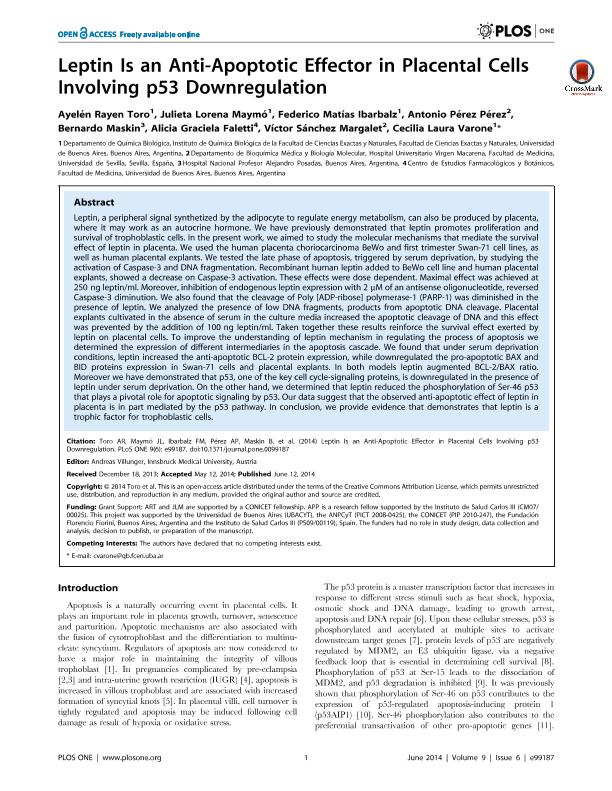Mostrar el registro sencillo del ítem
dc.contributor.author
Toro, Ayelen Rayen

dc.contributor.author
Maymo, Julieta Lorena

dc.contributor.author
Ibarbalz, Federico Matias

dc.contributor.author
Pérez Pérez, Antonio
dc.contributor.author
Maskin, Bernardo
dc.contributor.author
Faletti, Alicia Graciela

dc.contributor.author
Sánchez Margalet, Víctor
dc.contributor.author
Varone, Cecilia Laura

dc.date.available
2017-03-07T18:51:53Z
dc.date.issued
2014-06
dc.identifier.citation
Toro, Ayelen Rayen; Maymo, Julieta Lorena; Ibarbalz, Federico Matias; Pérez Pérez, Antonio; Maskin, Bernardo; et al.; Leptin is an anti-apoptotic effector in placental cells involving p53 downregulation; Public Library of Science; Plos One; 9; 6; 6-2014; e99187
dc.identifier.issn
1932-6203
dc.identifier.uri
http://hdl.handle.net/11336/13595
dc.description.abstract
Leptin, a peripheral signal synthetized by the adipocyte to regulate energy metabolism, can also be produced by placenta, where it may work as an autocrine hormone. We have previously demonstrated that leptin promotes proliferation and survival of trophoblastic cells. In the present work, we aimed to study the molecular mechanisms that mediate the survival effect of leptin in placenta. We used the human placenta choriocarcinoma BeWo and first trimester Swan-71 cell lines, as well as human placental explants. We tested the late phase of apoptosis, triggered by serum deprivation, by studying the activation of Caspase-3 and DNA fragmentation. Recombinant human leptin added to BeWo cell line and human placental explants, showed a decrease on Caspase-3 activation. These effects were dose dependent. Maximal effect was achieved at 250 ng leptin/ml. Moreover, inhibition of endogenous leptin expression with 2 µM of an antisense oligonucleotide, reversed Caspase-3 diminution. We also found that the cleavage of Poly [ADP-ribose] polymerase-1 (PARP-1) was diminished in the presence of leptin. We analyzed the presence of low DNA fragments, products from apoptotic DNA cleavage. Placental explants cultivated in the absence of serum in the culture media increased the apoptotic cleavage of DNA and this effect was prevented by the addition of 100 ng leptin/ml. Taken together these results reinforce the survival effect exerted by leptin on placental cells. To improve the understanding of leptin mechanism in regulating the process of apoptosis we determined the expression of different intermediaries in the apoptosis cascade. We found that under serum deprivation conditions, leptin increased the anti-apoptotic BCL-2 protein expression, while downregulated the pro-apoptotic BAX and BID proteins expression in Swan-71 cells and placental explants. In both models leptin augmented BCL-2/BAX ratio. Moreover we have demonstrated that p53, one of the key cell cycle-signaling proteins, is downregulated in the presence of leptin under serum deprivation. On the other hand, we determined that leptin reduced the phosphorylation of Ser-46 p53 that plays a pivotal role for apoptotic signaling by p53. Our data suggest that the observed anti-apoptotic effect of leptin in placenta is in part mediated by the p53 pathway. In conclusion, we provide evidence that demonstrates that leptin is a trophic factor for trophoblastic cells.
dc.format
application/pdf
dc.language.iso
eng
dc.publisher
Public Library of Science

dc.rights
info:eu-repo/semantics/openAccess
dc.rights.uri
https://creativecommons.org/licenses/by/2.5/ar/
dc.subject
Leptina
dc.subject
Placenta
dc.subject
Apoptosis
dc.subject
P53
dc.subject.classification
Bioquímica y Biología Molecular

dc.subject.classification
Ciencias Biológicas

dc.subject.classification
CIENCIAS NATURALES Y EXACTAS

dc.title
Leptin is an anti-apoptotic effector in placental cells involving p53 downregulation
dc.type
info:eu-repo/semantics/article
dc.type
info:ar-repo/semantics/artículo
dc.type
info:eu-repo/semantics/publishedVersion
dc.date.updated
2017-03-06T17:06:58Z
dc.journal.volume
9
dc.journal.number
6
dc.journal.pagination
e99187
dc.journal.pais
Estados Unidos

dc.journal.ciudad
San Francisco
dc.description.fil
Fil: Toro, Ayelen Rayen. Consejo Nacional de Investigaciones Científicas y Técnicas. Oficina de Coordinación Administrativa Ciudad Universitaria. Instituto de Química Biológica de la Facultad de Ciencias Exactas y Naturales; Argentina
dc.description.fil
Fil: Maymo, Julieta Lorena. Consejo Nacional de Investigaciones Científicas y Técnicas. Oficina de Coordinación Administrativa Ciudad Universitaria. Instituto de Química Biológica de la Facultad de Ciencias Exactas y Naturales; Argentina
dc.description.fil
Fil: Ibarbalz, Federico Matias. Consejo Nacional de Investigaciones Científicas y Técnicas. Oficina de Coordinación Administrativa Ciudad Universitaria. Instituto de Química Biológica de la Facultad de Ciencias Exactas y Naturales; Argentina
dc.description.fil
Fil: Pérez Pérez, Antonio. Universidad de Sevilla; España
dc.description.fil
Fil: Maskin, Bernardo. Hospital Nacional Profesor Alejandro Posadas; Argentina
dc.description.fil
Fil: Faletti, Alicia Graciela. Consejo Nacional de Investigaciones Científicas y Técnicas. Oficina de Coordinación Administrativa Houssay. Centro de Estudios Farmacológicos y Botánicos; Argentina. Universidad de Buenos Aires; Argentina
dc.description.fil
Fil: Sánchez Margalet, Víctor. Universidad de Sevilla; España
dc.description.fil
Fil: Varone, Cecilia Laura. Consejo Nacional de Investigaciones Científicas y Técnicas. Oficina de Coordinación Administrativa Ciudad Universitaria. Instituto de Química Biológica de la Facultad de Ciencias Exactas y Naturales; Argentina
dc.journal.title
Plos One

dc.relation.alternativeid
info:eu-repo/semantics/altIdentifier/url/http://journals.plos.org/plosone/article?id=10.1371/journal.pone.0099187
dc.relation.alternativeid
info:eu-repo/semantics/altIdentifier/doi/http://dx.doi.org/10.1371/journal.pone.0099187
Archivos asociados
